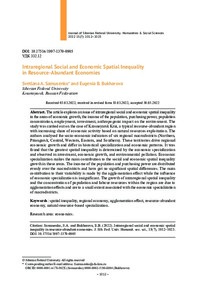Внутрирегиональное социальное и экономическое пространственное неравенство в ресурсных экономиках
Скачать файл:
URI (для ссылок/цитирований):
https://elib.sfu-kras.ru/handle/2311/145598Автор:
Самусенко, С. А.
Бухарова, Е. Б.
Samusenko, Svetlana A.
Bukharova, Eugenia B.
Дата:
2022-07Журнал:
Журнал Сибирского федерального университета. Гуманитарные науки. Journal of Siberian Federal University. Humanities & Social Sciences; 2022 15 (7)Аннотация:
В статье исследуется внутрирегиональное социальное и экономическое
пространственное неравенство в сферах экономического роста, доходов
и покупательной способности населения, концентрации населения и занятости,
инвестиций, антропогенного воздействия на окружающую среду. Исследование
выполнено на примере Красноярского края, региона с выраженной и нарастающей
ресурсной специализацией. Объектами исследования стали шесть макрорайонов
(Северный, Приангарский, Центральный, Западный, Восточный и Южный), которые
являются точками роста и различаются исторически сложившейся специализацией
и паттернами хозяйствования. Показано, что наибольшее пространственное
неравенство наблюдается в сферах, обусловленных сырьевой специализацией
региона: инвестициях, экологии, экономическом росте. Фактор специализации
территории вносит основной вклад в рост социального и экономического
пространственного неравенства по этим направлениям. Доходы и покупательная
способность населения распределены по территориям равномерно и не подвержены
существенным пространственным различиям. Основной вклад в их вариабельность
вносит агломерационный эффект, влияние специализации незначительно. Рост
пространственного неравенства и концентрация населения и трудовых ресурсов
внутри региона обусловлены агломерационным эффектом и в малой степени связаны
со специализацией территорий The article explores an issue of intraregional social and economic spatial inequality in the areas of economic growth, the income of the population, purchasing power, population concentration, employment, investment, anthropogenic impact on the environment. The study was carried out on the case of Krasnoyarsk Krai, a typical recourse-abundant region with increasing share of economic activity based on natural resources exploitation. The authors analysed the socio-economic indicators of six regional macrodistricts (Northern, Priangarsk, Central, Western, Eastern, and Southern). These territories drive regional economic growth and differ in historical specialization and economic patterns. It was found that the greatest spatial inequality is determined by the economic specialization and observed in investment, economic growth, and environmental pollution. Economic specialization makes the main contribution to the social and economic spatial inequality growth in these areas. The income of the population and purchasing power are distributed evenly over the macrodistricts and have got no significant spatial differences. The main contribution to their variability is made by the agglomeration effect while the influence of economic specialization is insignificant. The growth of intraregional spatial inequality and the concentration of population and labour resources within the region are due to agglomeration effects and are to a small extent associated with the economic specialization of macrodistricts

